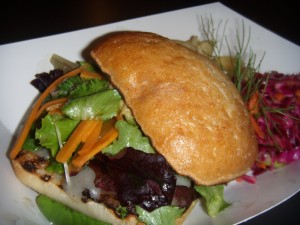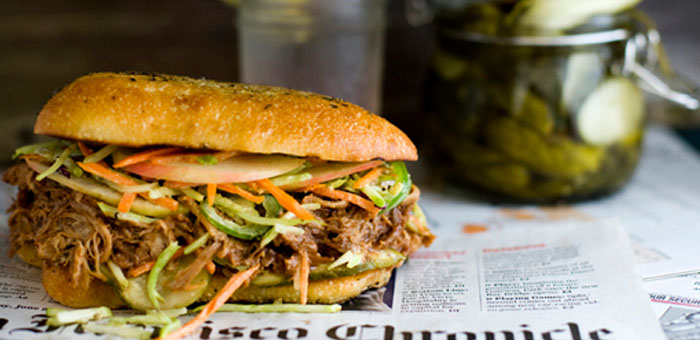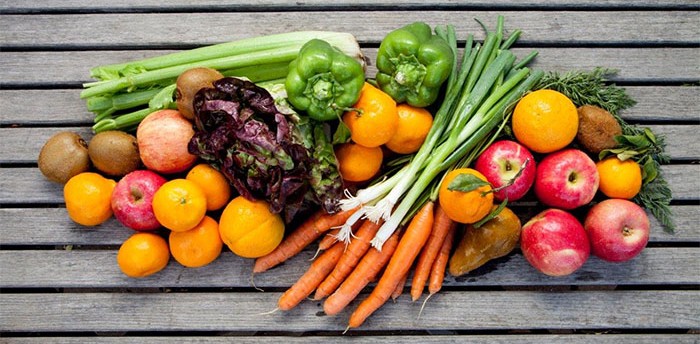Sandwich Anatomy
Bread
Different breads have different characteristics that should be considered when constructing any sandwich. Almost any bread can be used to make a sandwich. The first thing to consider when choosing the bread for a sandwich is whether the bread can support the sandwich ingredients. The texture should stand up to the moisture from the spread, dressing, and filling without becoming soggy or gummy. Second, the bread should not be so thick that it overwhelms the sandwich. And the bread should complement other ingredients in the sandwich.
Most but not all breads used in sandwiches are sliced; it is important to keep the bread covered or wrapped so it does not dry out. The bread should be fresh; one-day-old bread is actually the best for slicing and toasting.
Types of breads used in most sandwiches:
Wrappers—Flour, flavored (e.g., herb or sundried tomato), or wheat tortillas and similar flexible flatbreads are used in specialty sandwiches.
Flatbreads—These include pizz), pita, ciabatta, focaccia, chapatis, naan, and poori, which may be split before filling or used as the base for an open-faced sandwich.
Fine-grain breads—White, wheat, rye, marble rye, or any flavored fine-grain bread may be used. Store soft-crusted breads in their wrappers at 75°F to 85°F.
Coarsely grained or artisan-style breads—Breads such as pumpernickel, sourdough, pan de champagne, French, Italian, and boule are great for larger sandwiches. Must sure that this type of bread is not overly hard or crusty, which may make the sandwich too difficult to eat.
Rolls, both hard and soft—Hoagie, submarine, and Kaiser rolls are examples; all should be split before filling.
Spreads
 Spreads are used to add flavor and moisture, as well as provide a barrier between the filling and the bread. Typically, spreads are fat-based, such as mayonnaise or butter. The spread not only keeps the bread from getting soggy, but also adds moisture and helps hold the bread together as it is being eaten. Spreads can be part of the filling or applied directly on the bread.
Spreads are used to add flavor and moisture, as well as provide a barrier between the filling and the bread. Typically, spreads are fat-based, such as mayonnaise or butter. The spread not only keeps the bread from getting soggy, but also adds moisture and helps hold the bread together as it is being eaten. Spreads can be part of the filling or applied directly on the bread.
Spreads can be as simple as plain butter or as complex as an ancho-flavored roasted vegetable purée. Because it is meant to be spread thinly, butter should be softened or whipped so that it can be spread without tearing the bread. Mayonnaise (plain or flavored, such as aïoli) or a creamy salad dressing is often used as a spread. Yogurt-based spreads or dressings are popular on Middle Eastern sandwiches. Vegetables purées are sandwich spread staples, such as puréed roasted peanuts, and peanut butter. Other options include Greek tzatziki sauce (garlic cucumber sauce) used on gyro sandwiches, salsa or guacamole for tacos, and olive tapenade for a New Orleans muffuletta. However, unlike fat-based spreads, vegetable-based spreads usually do not provide a moisture barrier between the bread and the filling. Other spreads may include spreadable cheeses, such as ricotta, cream cheese, or mascarpone, and fruit jelly, jam, or chutney.
Fillings
As with the center-of-the-plate concept for entrées, the sandwich filling should be the focus of a sandwich. Ingredients must be of high quality and properly prepared, and flavors should complement each other. The kind of filling used usually gives the sandwich its name and character. Sliced meats and cheeses are most often used, but salad mixtures such as tuna or chicken salad are just as popular. Salad mixtures should be of good consistency, neither too dry nor too moist. Meat, cheese, and other sliced ingredients should fit the bread and be sliced evenly. For cold sandwiches, the fillings should be precooked, well-seasoned, and completely chilled. In classical sandwiches such as a Reuben, which has three primary ingredients—corned beef, Swiss cheese, and sauerkraut—or a pulled pork barbecue sandwich with slaw, all the ingredients work together to balance the flavors. Consideration should also be given to texture as well as flavor.
Typical garnishes for sandwiches include pickles, olives, coleslaw, fruit salad, and potato chips. Most sandwiches, predominantly cold, closed sandwiches, are cut into halves, thirds, or quarters for service. Cutting makes the sandwich easier for your customers to handle and allows for a more creative and attractive presentation. Condiments such as mayonnaise, mustard, sliced tomatoes, onions, and lettuce leaves can be served on the side.
Guidelines for Sandwich Making
All sandwich ingredients should be prepared ahead of service—meats and cheeses sliced, lettuce leaves washed and dried, tomatoes sliced, salads and spreads completely prepared. If items are proportioned by either weight or count, it should be done before your truck opens up its service window.
Work flow is also an important factor in minimizing movement and maximizing efficiency. Arrange items so there is flow when assembling a sandwich. Cold items must be refrigerated at proper temperatures at all times. A sandwich bar/station resembles a steam table but with refrigerated compartments.
The typical sandwich food truck kitchen usually contains a griddle, an open or sealed hot top, and perhaps a broiler, meat slicer, deep-fryer, microwave, and refrigerated sandwich bar/station. Laying out the equipment properly will help develop good work patterns to make for easier work and faster production which will ultimately lead to more sales.




